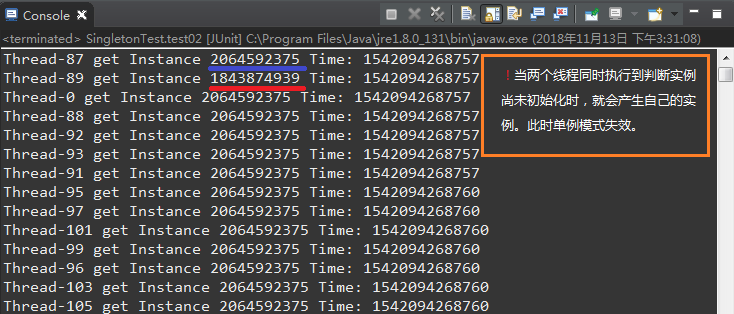1.最基本的单例模式
/** * @author LearnAndGet * @time 2018年11月13日 * 最基本的单例模式 */ public class SingletonV1 { private static SingletonV1 instance = new SingletonV1();; //构造函数私有化 private SingletonV1() {} public static SingletonV1 getInstance() { return instance; } }
import org.junit.Test; public class SingletonTest { @Test public void test01() throws Exception { SingletonV1 s1 = SingletonV1.getInstance(); SingletonV1 s2 = SingletonV1.getInstance(); System.out.println(s1.hashCode()); System.out.println(s2.hashCode()); } } //运行结果如下: 589873731 589873731
2.类加载时不初始化实例的模式
上述单例模式在类加载的时候,就会生成实例,可能造成空间浪费,如果需要修改成,在需要使用时才生成实例,则可修改代码如下:
1 public class SingletonV2 { 2 3 private static SingletonV2 instance; 4 5 //构造函数私有化 6 private SingletonV2() {} 7 8 public static SingletonV2 getInstance(){ 10 if(instance == null) 11 { 12 instance = new SingletonV2(); 13 } 14 return instance; 15 } 16 }
然而,上述方案虽然在类加载时不会生成实例,但是存在线程安全问题,如果线程A在执行到第10行时,线程B也进入该代码块,恰好也执行好第10行,此时如果实例尚未生成,则线程A和线程B都会执行第12行的代码,各自生成一个实例,此时就违背了单例模式的设计原则。实际测试代码如下:
public class SingletonTest { @Test public void test02() throws Exception { for(int i=0;i<1000;i++) { Thread th1 = new getInstanceThread(); th1.start(); } } class getInstanceThread extends Thread { public void run() { try { SingletonV2 s = SingletonV2.getInstance(); System.out.println(Thread.currentThread().getName()+" get Instance "+s.hashCode()+" Time: "+System.currentTimeMillis()); }catch(Exception e) { e.printStackTrace(); } } } }
经过多次测试,可能产生如下输出结果:

3.线程安全的单例模式
在上述单例模式下进行改进,在getInstance方法前加入 Sychronized关键字,来实现线程安全,修改后代码如下:
1 public class SingletonV3 { 2 3 private static SingletonV3 instance; 4 5 //构造函数私有化 6 private SingletonV3() {} 7
//synchronized关键字在静态方法上,锁定的是当前类:sychronized关键字 8 public static synchronized SingletonV3 getInstance() 9 { 10 if(instance == null) 11 { 12 instance = new SingletonV3(); 13 } 14 return instance; 15 } 16 }
增加sychronized关键字后,确实能够改善线程安全问题,但是也带来了额外的锁开销。性能受到一定影响。举例来说,此时如果有1000个线程都需要使用SingletonV3实例,因为加锁的位置在getInstance上,因此,每个线程都必须等待其他获取了锁的线程完全执行完锁中的方法后,才能够进入该方法并获取自己的实例。
4.双重校检+线程安全单例模式
于是可以在上述代码的基础上,只有当Singleton实例未被初始化时,对实例化方法加锁即可。在Singleton实例已经被初始化时,无需加锁,直接返回当前Singleton对象。代码如下:
1 private static SingletonV4 instance; 2 3 //构造函数私有化 4 private SingletonV4() {} 5 6 public static SingletonV4 getInstance() 7 { 8 if(instance == null) 9 { 10 synchronized(SingletonV4.class) 11 { 12 //双重校检 13 if(instance == null) 14 { 15 instance = new SingletonV4(); 16 } 17 } 18 } 19 return instance; 20 }
5.内部类单例模式
尽管上述方案解决了同步问题,双重校检也使得性能开销大大减小,但是,只有有synchronized关键字的存在。性能多多少少还是会有一些影响,此时,我们想到了 "内部类"的用法。
①.内部类不会随着类的加载而加载
②.一个类被加载,当且仅当其某个静态成员(静态域、构造器、静态方法等)被调用时发生。
静态内部类随着方法调用而被加载,只加载一次,不存在并发问题,所以是线程安全。基于此,修改代码如下:
/推荐指数:★★★★★
1 public class SingletonV5 { 2 //构造函数私有化 3 private SingletonV5() {} 4 5 static class SingetonGet 6 { 7 private static final SingletonV5 instance = new SingletonV5(); 8 } 9 10 public static SingletonV5 getInstance() 11 { 12 return SingetonGet.instance; 13 } 14 }
6.反射都不能破坏的单例模式
静态内部类实现的单例模式,是目前比较推荐的方式,但是在java功能强大反射的机制下,它就是个弟弟,此时利用反射仍然能够创建出多个实例,以下是创建实例的代码:
1 @Test 2 public void test4() 3 { 4 //普通方式获取实例s1,s2 5 SingletonV5 s1 = SingletonV5.getInstance(); 6 SingletonV5 s2 = SingletonV5.getInstance(); 7 //利用反射获取实例s3,s4 8 SingletonV5 s3 = null; 9 SingletonV5 s4 = null; 10 try 11 { 12 Class<SingletonV5> clazz = SingletonV5.class; 13 Constructor<SingletonV5> constructor = clazz.getDeclaredConstructor(); 14 constructor.setAccessible(true); 15 s3 = constructor.newInstance(); 16 s4 = constructor.newInstance(); 17 }catch(Exception e) 18 { 19 e.printStackTrace(); 20 } 21 22 System.out.println(s1.hashCode()); 23 System.out.println(s2.hashCode()); 24 System.out.println(s3.hashCode()); 25 System.out.println(s4.hashCode()); 26 }
输出结果如下:
589873731 589873731 200006406 2052001577
可以看到,s1和s2拥有相同的哈希码,因此他们是同一个实例,但是s3、s4,是通过反射后用构造函数重新构造生成的实例,他们均与s1,s2不同。此时单例模式下产生了多个不同的对象,违反了设计原则。
基于上述反射可能造成的单例模式失效,考虑在私有的构造函数中添加是否初始化的标记位,使私有构造方法只可能被执行一次。
public class SingletonV6 { //是否已经初始化过的标记位 private static boolean isInitialized = false; //构造函数中,当实例已经被初始化时,不能继续获取新实例 private SingletonV6() { synchronized(SingletonV6.class) { if(isInitialized == false) { isInitialized = !isInitialized; }else { throw new RuntimeException("单例模式被破坏..."); } } } static class SingetonGet { private static final SingletonV6 instance = new SingletonV6(); } public static SingletonV6 getInstance() { return SingetonGet.instance; } }
测试代码如下:
@Test public void test5() { SingletonV6 s1 = SingletonV6.getInstance(); SingletonV6 s2 = null; try { Class<SingletonV6> clazz = SingletonV6.class; Constructor<SingletonV6> constructor = clazz.getDeclaredConstructor(); constructor.setAccessible(true); s2 = constructor.newInstance(); }catch(Exception e) { e.printStackTrace(); } System.out.println(s1.hashCode()); System.out.println(s2.hashCode()); }
运行上述代码时,会抛出异常:
java.lang.reflect.InvocationTargetException at sun.reflect.NativeConstructorAccessorImpl.newInstance0(Native Method) at sun.reflect.NativeConstructorAccessorImpl.newInstance(Unknown Source) at sun.reflect.DelegatingConstructorAccessorImpl.newInstance(Unknown Source) at java.lang.reflect.Constructor.newInstance(Unknown Source) at SingletonTest.SingletonTest.test5(SingletonTest.java:98) at sun.reflect.NativeMethodAccessorImpl.invoke0(Native Method) at sun.reflect.NativeMethodAccessorImpl.invoke(Unknown Source) at sun.reflect.DelegatingMethodAccessorImpl.invoke(Unknown Source) at java.lang.reflect.Method.invoke(Unknown Source) at org.junit.runners.model.FrameworkMethod$1.runReflectiveCall(FrameworkMethod.java:50) at org.junit.internal.runners.model.ReflectiveCallable.run(ReflectiveCallable.java:12) at org.junit.runners.model.FrameworkMethod.invokeExplosively(FrameworkMethod.java:47) at org.junit.internal.runners.statements.InvokeMethod.evaluate(InvokeMethod.java:17) at org.junit.runners.ParentRunner.runLeaf(ParentRunner.java:325) at org.junit.runners.BlockJUnit4ClassRunner.runChild(BlockJUnit4ClassRunner.java:78) at org.junit.runners.BlockJUnit4ClassRunner.runChild(BlockJUnit4ClassRunner.java:57) at org.junit.runners.ParentRunner$3.run(ParentRunner.java:290) at org.junit.runners.ParentRunner$1.schedule(ParentRunner.java:71) at org.junit.runners.ParentRunner.runChildren(ParentRunner.java:288) at org.junit.runners.ParentRunner.access$000(ParentRunner.java:58) at org.junit.runners.ParentRunner$2.evaluate(ParentRunner.java:268) at org.junit.runners.ParentRunner.run(ParentRunner.java:363) at org.eclipse.jdt.internal.junit4.runner.JUnit4TestReference.run(JUnit4TestReference.java:86) at org.eclipse.jdt.internal.junit.runner.TestExecution.run(TestExecution.java:38) at org.eclipse.jdt.internal.junit.runner.RemoteTestRunner.runTests(RemoteTestRunner.java:538) at org.eclipse.jdt.internal.junit.runner.RemoteTestRunner.runTests(RemoteTestRunner.java:760) at org.eclipse.jdt.internal.junit.runner.RemoteTestRunner.run(RemoteTestRunner.java:460) at org.eclipse.jdt.internal.junit.runner.RemoteTestRunner.main(RemoteTestRunner.java:206) Caused by: java.lang.RuntimeException: 单例模式被破坏... at SingletonTest.SingletonV6.<init>(SingletonV6.java:26) ... 28 more 2052001577
7.序列化反序列化都不能破坏的单例模式
经过上述改进,反射也不能够破坏单例模式了。但是,依然存在一种可能造成上述单例模式产生两个不同的实例,那就是序列化。当一个对象A经过序列化,然后再反序列化,获取到的对象B和A是否是同一个实例呢,验证代码如下:
/** * @Author {LearnAndGet} * @Time 2018年11月13日 * @Discription:测试序列化并反序列化是否还是同一对象 */ package SingletonTest; import java.io.FileInputStream; import java.io.FileOutputStream; import java.io.ObjectInput; import java.io.ObjectInputStream; import java.io.ObjectOutput; import java.io.ObjectOutputStream; public class Main { /** * @param args */ public static void main(String[] args) { // TODO Auto-generated method stub SingletonV6 s1 = SingletonV6.getInstance(); ObjectOutput objOut = null; try { //将s1序列化(记得将Singleton实现Serializable接口) objOut = new ObjectOutputStream(new FileOutputStream("c:\a.objFile")); objOut.writeObject(s1); objOut.close(); //反序列化得到s2 ObjectInput objIn = new ObjectInputStream(new FileInputStream("c:\a.objFile")); SingletonV6 s2 = (SingletonV6) objIn.readObject(); objIn.close(); System.out.println(s1.hashCode()); System.out.println(s2.hashCode()); } catch (Exception e) { // TODO Auto-generated catch block e.printStackTrace(); } } }
输出结果如下:
1118140819 990368553
可见,此时序列化前的对象s1和经过序列化->反序列化步骤后的到的对象s2,并不是同一个对象,因此,出现了两个实例,再次违背了单例模式的设计原则。
为了消除问题,在单例模式类中,实现Serializable接口之后 添加对readResolve()方法的实现:当从I/O流中读取对象时,readResolve()方法都会被调用到。实际上就是用readResolve()中返回的对象直接替换在反序列化过程中创建的对象,而被创建的对象则会被垃圾回收掉。这就确保了在序列化和反序列化的过程中没人可以创建新的实例,修改后的代码如下:
package SingletonTest; import java.io.Serializable; /** * @author LearnAndGet * * @time 2018年11月13日 * */ public class SingletonV6 implements Serializable{ //是否已经初始化过的标记位 private static boolean isInitialized = false; //构造函数中,当实例已经被初始化时,不能继续获取新实例 private SingletonV6() { synchronized(SingletonV6.class) { if(isInitialized == false) { isInitialized = !isInitialized; }else { throw new RuntimeException("单例模式被破坏..."); } } } static class SingetonGet { private static final SingletonV6 instance = new SingletonV6(); } public static SingletonV6 getInstance() { return SingetonGet.instance; } //实现readResolve方法 private Object readResolve() { return getInstance(); } }
重新运行上述序列化和反序列过程,可以发现,此时得到的对象是同一对象。
1118140819 1118140819
8.总结
在实际开发中,根据自己的需要,选择对应的单例模式即可,不一样非要实现第7节中那种无坚不摧的单例模式。毕竟不是所有场景下都需要实现序列化接口, 也并不是所有人都会用反射来破坏单例模式。因此比较常用的是第5节中的,内部类单例模式,代码简洁明了,且节省空间。